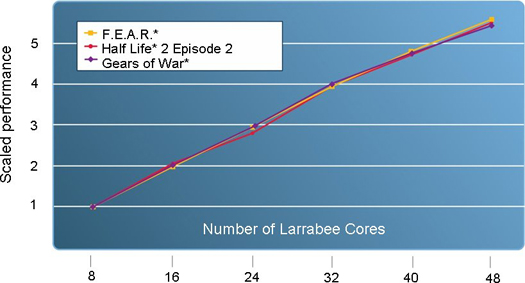Intel's Larrabee Architecture Disclosure: A Calculated First Move
by Anand Lal Shimpi & Derek Wilson on August 4, 2008 12:00 AM EST- Posted in
- GPUs
How Many Cores in a Larrabee?
Initial estimates put Larrabee at somewhere in the 16 to 32-core range, we figured 32-cores would be a sweetspot (not in the least because Intel's charts and graphs showed diminishing returns over 32 cores) but 24-cores would be more likely for an initial product. Intel however shared some data that made us question all of that.

Remember the design experiment? Intel was able to fit a 10-core Larrabee into the space of a Core 2 Duo die. Given the specs of the Core 2 Duo Intel used (4MB L2 cache), it appears to be a 65nm Conroe/Merom based Core 2 Duo - with a 143 mm^2 die size.
At 143 mm^2, Intel could fit 10 Larrabee-like cores so let's double that. Now we're at 286mm^2 (still smaller than GT200 and about the size of AMD's RV770) and 20-cores. Double that once more and we've got 40-cores and have a 572mm^2 die, virtually the same size as NVIDIA's GT200 but on a 65nm process.
The move to 45nm could scale as well as 50%, but chances are we'll see something closer to 60 - 70% of the die size simply by moving to 45nm (which is the node that Larrabee will be built on). Our 40-core Larrabee is now at ~370mm^2 on 45nm. If Intel wanted to push for a NVIDIA-like die size we could easily see a 64-core Larrabee at launch for the high end, with 24 or 32-core versions aiming at the mainstream. Update: One thing we did not consider here is power limitations. So while Intel may be able to produce a 64-core Larrabee with a GT200-like die-size, such a chip may exceed physical power limitations. It's far more likely that we'll see something in the 16 - 32 core range at 45nm due to power constraints rather than die size constraints.
This is all purely speculation but it's a discussion that was worth having publicly.










101 Comments
View All Comments
Griswold - Monday, August 4, 2008 - link
You seem to be confused. Time for a nap.MDme - Monday, August 4, 2008 - link
but AMD will have Cinema 2.0. did you see that demo? by 2010, AMD will have the RV990 or whatever...and Nvidia will have GT400?phaxmohdem - Monday, August 4, 2008 - link
Considering how long it took nVidia to release a single GPU significantly faster than G80, I'd be shocked if we wee GT300 by 2009/2010. however a GTX 295GT X2 ULTRA OC is not out of the question ;)shuffle2 - Monday, August 4, 2008 - link
mm², how hard is that to write? >.>1prophet - Monday, August 4, 2008 - link
They need to hit one out of the park with the drivers (software)as well.jltate - Tuesday, August 5, 2008 - link
I've got a bunch of comments, so I'll just list them all here.SSE doesn't have fused multiply-add operations. Larrabee does -- thus that 10 core processor could perform a peak of 320 floating point operations per cycle (it's mentioned in the SIGGRAPH paper).
Larrabee's programming model is variable width -- the hardware can and likely will be augmented in the future to perform more than just 16 operations in parallel.
The ring bus between cores was stated to be for each group of 16. Intel stated that for more than 16 cores they'd use "multiple short-linked rings".
Also, the diagram only shows one memory controller on one side with fixed function logic on the other, not two memory controllers as you showed on page 5 of your article. However, Intel stated in the paper that the configuration and number of processors, fixed function blocks and I/O controllers would be implementation dependent. So in effect it could very well have a half-dozen 64-bit interfaces like G80.
My forecast? This thing will rock. I for one simply cannot wait.
Laura Wilson - Monday, August 4, 2008 - link
that's the truththey say they know this. it sounds like they know this ... we'll see what happens :-)
gigahertz20 - Monday, August 4, 2008 - link
I'm going to predict Larrabee will provide a huge boost of performance over Intel's current crappy integrated graphic solutions, but will not be able to compete with AMD/ATI's and Nvidia's high end GPU's when it (Larrabee) finally launches. If Intel can deliver a monster that can push 100+ FPS in Crysis and doesn't cost so much that it breaks the bank like the current Nvidia GTX 280's, then they will have a real winner! When it finally launches though, who knows what AMD/ATI and Nvidia will have out to compete against it, wonder if Intel is just trying to push out a mainstream chip or go high end as well...guess I need to read the rest of the article :)JEDIYoda - Tuesday, August 5, 2008 - link
dreaming again huh??? you people who want top notch performance without having to pay for it....rofl..hahahaFITCamaro - Monday, August 4, 2008 - link
This isn't mean to compete with their IGPs. At least not initially.